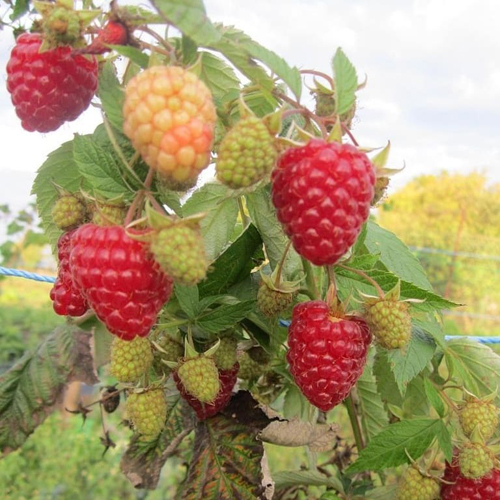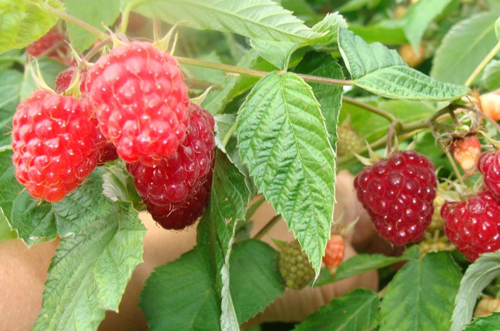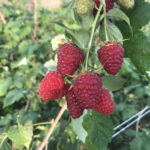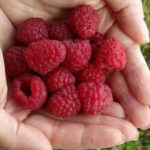Raspberry grade Diamond
Raspberry Brilliant is really a precious stone of domestic selection, bred by scientists from the leading specialized scientific institution - the All-Russian Institute of Selection and Technology of Horticulture and Nursery (VSTISP). In the work on the variety, carried out on the basis of the Kokinsky strong point of the Institute located in the Bryansk region, a group of researchers including I.V. Kazakova, V.L. Kulagina, S.N. Evdokimenko, I. Ya. Us. Through interspecific hybridization, they managed to endow their offspring with a number of excellent characteristics, which ensured recognition for it from both industrialists and amateur gardeners.

It is worth noting that the head of the team of authors - Doctor of Agricultural Sciences and Academician of the Russian Academy of Agricultural Sciences Ivan Kazakov was almost the main specialist in culture in our country and a world-renowned scientist. Since the 70s of the last century, one of the main directions of his work has been to obtain new remontant varieties of raspberries with a short growing season, and therefore are able to largely realize their yield potential in relatively northern regions. Interest in remontant varieties was due to the advantages that plants of this type possessed. This is, first of all, the highest winter hardiness of the bushes that bear fruit on annual shoots, after which the stems are removed, and the plant hibernates completely covered with snow. Well, and secondly, this is a significant improvement in the phytosanitary state of plantings, associated with the annual destruction of the vegetative mass on which pests and pathogens are used to multiply.
Our heroine also turned out to be the owner of such positive qualities, combining them with heat tolerance, comparative drought resistance, high productivity and good gastronomic and aesthetic characteristics of the fruits.
Due to the complex of its positive properties, during the state test, Brilliantovaya, in just three years, managed to prove its right to be called a variety, and in 2006 it was officially included in the State Register of Breeding Achievements of the Russian Federation with a recommendation for industrial cultivation in the Central non-chernozem region. However, the variety was spread far beyond its borders by amateurs in a short time, and over the past years it has managed to demonstrate high plasticity and the ability to perfectly bear fruit in a variety of soil and climatic conditions.

Agrobiological properties
In the course of cultivation, the plants show an average vigor, rarely exceeding one and a half meters in height. The bushes are spreading, without a garter, the shoots are strongly bent under the weight of a significant number of fruits, sometimes practically lying on the ground. This fact indicates the need for a mandatory arrangement of trellises, or other supports to maintain the stems in an upright position. The activity of the formation of replacement shoots is variable and depends on the moisture supply of the climate. Under normal conditions, their number does not exceed five to six, and in regions with a significant amount of precipitation or during wet seasons, this number increases slightly. The shoots of the first year of life are colored purple; on their surface, a significant waxy bloom and slight pubescence are noticeable. The stud is low, which allows you to take care of the plants and harvest without unnecessary difficulties. The thorns are concentrated mainly at the base of the stems, they are medium in size, soft, have a pigmentation similar to the color of the shoots. If the aerial part of the plants is not cut off in the fall, then in the second year the stems become light brown. The leaves of the variety are medium in size, can consist of three or five simple green leaves with anthocyanin tones, have a wrinkled surface and a slightly curled shape.Numerous pointed denticles are located along the perimeter of the leaf blades. Laterals are very numerous, begin to form above the middle of the shoot, and therefore the fruit zone occupies its upper part. Fruit branches are smooth, without thorns and pubescence, but covered with a thick bloom of wax. They branch well and bear a significant number of flowers and ovaries. Root shoots do not grow too intensively, and therefore keeping the site in a neat condition will not require excessive hassle, but you should not count on the rapid reproduction of raspberries by offspring due to a shortage of planting material.

Shoots of the current year begin to bloom in July. The flowers are medium in size, with smaller stamens than the pistils. There are five sepals of moderate size, they have simple pubescence. In early August, the berries begin to ripen and the fruiting process continues until the first frost. During this period, the plants manage to realize their yield potential by an average of 85 - 90%. In years with warm, long autumn, this parameter turns out to be higher, and in cool seasons, it is somewhat less. Usually, with good care, you can collect up to 2 - 2.5 kg of berries from a bush, and from a hectare of area, according to the most conservative estimates, up to 80 - 100 centners. Theoretically, it is possible to obtain two harvests per season, if the shoots are left for the second year, however, early summer fruiting often delays the receipt of the bulk of the berries in August, which is why there may be more disadvantages than advantages from this approach. Ripe raspberries are well separated from the fruit of an elongated-conical shape, which makes it easy to harvest, and overripe fruits do not crumble and do not rot on the bush for a long time.
The collected berries are large in size, 20 - 21 mm high and about 18 - 19 mm in diameter, conical, ruby red and have a strong shine, for which the variety obviously got its name. The average fruit weight is about 4 grams. Their pubescence is barely noticeable, bones are felt when eating. The pulp is juicy, very tender, with a pleasant sweet-sour taste, however, the aroma typical of raspberries is practically not manifested. Because of this, Brillianttova's tasting ratings are at an average level, usually not exceeding 4.1 - 4.2 points. At the same time, biochemical analysis indicates a rich composition of the berries. In particular, the content of dry matter in them is 10 - 11%, the sum of sugars represented by glucose, fructose and sucrose reaches 8 - 8.5%, the total acidity is 1.3 - 1.5%. With 100 grams of fruit, the human body receives 30 - 35 mg of vitamin C, 10 - 15 mg of vitamin P and 170 - 180 mg of anthocyanins. Improving the illumination of plants during cultivation has a very positive effect both on the taste of the fruits obtained and on their nutritional value.
The harvest of the variety is very versatile in the way it is used. Fresh, this raspberry is in good demand among consumers, due, first of all, to its excellent appearance. Farmers also confirm the "market" variety, although they are somewhat annoyed by the not too high transportability of delicate berries. The latter circumstance requires a sparing treatment of our heroine, her collection in small containers and careful movement over short distances. For amateur gardeners cultivating Diamond for their own consumption, such nuances are less relevant. Here the surplus harvest is actively processed into juices, compotes, preserves, jams and confitures, and therefore even slightly substandard berries can always be used. Home preservation of this raspberry is traditionally brightly colored and delicious in taste. The preservation of vitamins and minerals at the same time reaches high values.
The economic characteristics of our heroine are also very worthy. It is distinguished by good resistance to many diseases and pests, as well as adverse environmental conditions,
The technology of cultivation of Brilliantova does not differ fundamentally from other remontant varieties of raspberries. Planting is carried out on flat areas or gentle slopes, where the main condition is good protection from the wind blowing snow from the raspberry tree in winter, and thereby exposing the plants to the danger of freezing. In this regard, open hills should be avoided, but excessively low places are also not suitable, albeit for a different reason - cold damp air often stagnates here, provoking outbreaks of fungal diseases.
The period of active productivity in plants lasts for 8-10 years, then the yield gradually decreases. After uprooting the plantings, it is possible to return the culture to its original place no earlier than after 5 - 6 years.








